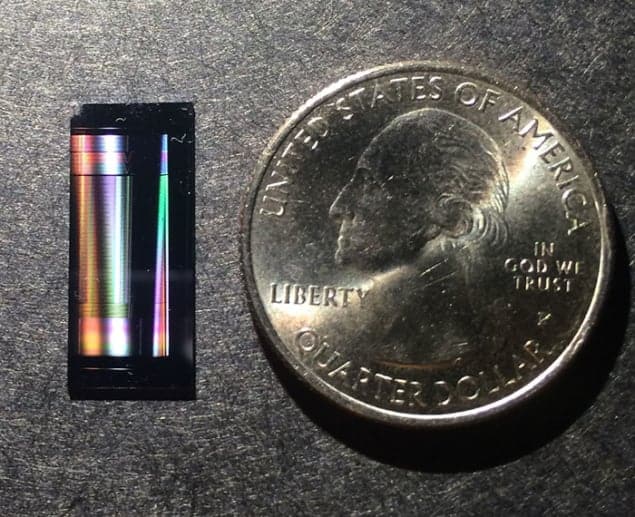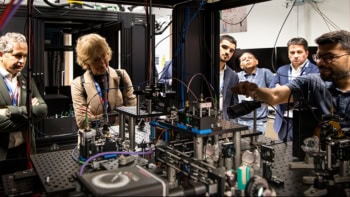
Engineers in the US have developed a chip that can convert visible light into infrared and back again, while preserving the quantum state of the original photons. This capability would allow quantum devices to transmit information to each other via the existing fibre-optic infrastructure. Researchers say this is a significant step in realizing a quantum network of devices and computers that can exchange information.
For more than a decade, researchers have been developing techniques to allow the construction of a network of quantum devices that could transmit quantum information to each other over long distances. Examples of these quantum devices include rubidium atoms in an ultracold gas and nitrogen-vacancy centres in a diamond. The information is held in the physical state of the individual particles in these systems – known as quantum bits or qubits. Like transistors in a classical circuit, these qubits could be capable of performing computations. Furthermore, quantum information could be exchanged between these stationary qubits by using photons as “flying qubits”.
An important challenge is how to transmit the output of one quantum device to another, says Hong Tang, an electrical engineer at Yale University who was involved in the work. When two quantum devices are based on two different physical systems, their output photons are not at the same frequency. “Unfortunately, most quantum devices operate at different frequencies and don’t really talk to each other,” he says.
Different colours
Even devices based on the same physical system can also run into trouble when quantum information must be transmitted over long distances. One problem is that fibre-optic networks are designed to transmit infrared light, whereas some qubits operate with visible light.
The new chip enables two devices operating at different frequencies to exchange information over long distances by using the existing infrared fibre-optic infrastructure. For example, if a rubidium-based device emitted a visible photon, the chip would convert that photon to an infrared frequency, which could then be transmitted via the fibre-optic network that makes up the Internet. Then, a chip connected to the second quantum device could receive and convert the infrared signal into a visible photon that is readable by its system.
Tang’s team is the first to achieve this precise frequency conversion on a chip. Unlike prior methods, these chips can be manufactured cheaply in large quantities.
Nonlinear ring
The frequency conversion occurs via a small semiconductor ring on the chip that is made of aluminium nitride. This ring is able to produce different frequencies of light via nonlinear effects. Tang’s team directed infrared and visible laser light at the ring using waveguides. They showed that this creates an infrared signal at a different frequency via a process called “difference-frequency generation”. When they sent in two infrared beams, they showed that visible light is produced via a process called “sum-frequency generation”.
“It’s a significant first step,” says Arka Majumdar at the University of Washington, who was not involved with the research. Majumdar is also developing components for a future quantum-network infrastructure. “This chip is like the wires in a classical circuit,” he explains.
The next step, Tang says, is to improve the chip’s frequency conversion efficiency. In the paper, they reported 14% efficiency. But this was due to poor connectivity, Tang says. In future experiments, they will aim to increase the conversion efficiency as high as 100%, which they have already demonstrated the semiconductor to be capable of doing.
Single photons
Majumdar points out that Tang and colleagues have yet to demonstrate that their chip can effectively convert single visible photons. But he has high hopes: “Within 10 years, I think we will be able to really communicate between two quantum systems,” he says.
The chip is described in Physical Review Letters.



